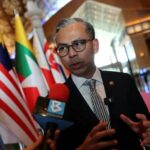Why Malaysia Is Taking Its Time
Malaysia is weighing a step that could reshape its economic diplomacy, whether to move from BRICS partner status to full membership. Foreign Minister Datuk Seri Mohamad Hasan told Parliament that Kuala Lumpur values engagement with the grouping but will not rush. The government wants to protect Malaysia’s longstanding neutrality and avoid actions that could box the country into one camp. For now, Malaysia will remain a partner.
- Why Malaysia Is Taking Its Time
- What Partner Status Means in Practice
- Economics at Stake for Kuala Lumpur
- Neutrality and Nonalignment in a Polarized Era
- Regional Picture ASEAN and BRICS
- Support and Signals From BRICS Capitals
- What Would Full Membership Change
- Risks, Red Lines, and Safeguards
- Timeline and What Comes Next
- Key Points
The minister said the country’s Reciprocal Trade Agreement with the United States includes clauses that leave policy choices to Malaysia. That assurance, he added, allows Kuala Lumpur to keep doors open with all major powers while it assesses the costs and benefits of a deeper BRICS role. As a partner, Malaysia sits in a waiting room of sorts, able to participate in dialogues but not to drive outcomes.
Neutrality first
Nonalignment has anchored Malaysian foreign policy since the early days of independence. Successive governments have sought broad ties, active participation in ASEAN, and pragmatic engagement with major economies without joining any security bloc. That approach helped Malaysia grow as a trading nation and navigate periods of rivalry among great powers. The current debate on BRICS is filtered through that same lens.
What Partner Status Means in Practice
Partner status was introduced when the enlarged BRICS met in Kazan in October 2024. Thirteen countries were invited to engage more closely with the bloc, and Malaysia accepted. Early this year, nine of those invitees took up formal partner roles across working groups and ministerial tracks. Partners are present in many meetings and can collaborate on projects, but they do not vote and they do not set the agenda.
Malaysia’s diplomats describe the arrangement as a bridge. It grants access to large markets and policy conversations among major emerging economies. It also gives Kuala Lumpur latitude to deepen cooperation where it sees a payoff and to pull back where interests diverge.
How it differs from full membership
Full members shape communiques and decisions, they have standing in every forum, and they carry more influence at institutions associated with BRICS, such as the New Development Bank. They also bear the political expectations that come with a seat at the table. Partner status provides visibility without the burdens of representation. That difference, officials say, is central to the present caution.
Economics at Stake for Kuala Lumpur
The economic case for closer ties is straightforward. The expanded BRICS group and its partners account for a large share of global output and trade on a purchasing power basis. Together they span energy producers, commodity powerhouses, and manufacturing giants. For Malaysia, which depends on external demand, the bloc is a vast customer base for electronics, palm oil, liquefied natural gas, processed foods, and professional services.
China remains Malaysia’s largest trading partner, with two way trade measured in the hundreds of billions of ringgit each year. Investment agreements and industrial cooperation with Chinese firms have grown steadily. India is a key buyer of palm oil and services. The Middle Eastern members add capital and energy connections. Access to BRICS policy circles can open doors for transport links, digital trade pilots, and supply chain resilience efforts that matter to Malaysian exporters.
Financing is part of the draw. The New Development Bank, backed by BRICS members, targets infrastructure and sustainable projects. Malaysia has no automatic claim to funding, yet regular engagement makes it easier to align proposals with the bank’s priorities. Green energy, grid upgrades, water management, and rail would all fit national plans. Decision makers in Kuala Lumpur see practical value in these channels even without a formal vote.
There are risks to weigh. The bloc has promoted settlement in local currencies and a reduced role for the dollar. That agenda appeals to many in the Global South, yet it can trigger friction with Washington. Some in Malaysia’s business community worry about tariff exposure and financial compliance if the country is viewed as leaning too close to a grouping that includes Russia and Iran. The cabinet is aware that any move must preserve access to the US, European Union, and Japanese markets that still buy a large share of Malaysian output.
Neutrality and Nonalignment in a Polarized Era
Malaysia’s foreign policy has long aimed for balance. The country is a member of ASEAN, participates in the Five Power Defence Arrangements, works closely with the United States on security and trade, and maintains robust ties with China and the wider Islamic world. That mix has served economic interests while keeping Malaysia away from hard alignments with any single camp.
Officials make a clear distinction between economic cooperation and strategic commitments. BRICS is an economic and political grouping, not a military alliance. Even so, perceptions matter. Kuala Lumpur wants to avoid choices that would be read as endorsements of any anti Western posture. The minister’s reference to clauses in the US reciprocal arrangement reflects a desire to keep strategic space open while expanding commercial options.
Avoiding binary choices
Policy planners describe a hedging approach. Malaysia will join dialogues that help its economy and its firms. It will also sustain free trade agreements that anchor ties with developed markets, including participation in the Regional Comprehensive Economic Partnership and the Comprehensive and Progressive Agreement for Trans Pacific Partnership. The aim is to add options, not to replace one set of economic ties with another.
Regional Picture ASEAN and BRICS
Southeast Asia is testing varied paths with the grouping. Indonesia became the first ASEAN country to secure full membership, seeking a bigger global voice and access to new finance. Thailand, Vietnam, and Malaysia accepted partner status to probe opportunities while limiting political exposure. Their approach reflects a shared preference for strategic autonomy and a gradual pace.
Malaysia will chair ASEAN next year. That role could give Kuala Lumpur scope to convene ASEAN level dialogues with BRICS ministries on trade facilitation, standards, tourism, and digital economy issues. Coordinated engagement through ASEAN helps distribute political risk and can deliver projects that make sense at a subregional scale, such as border crossings, power interconnections, and maritime cooperation.
Support and Signals From BRICS Capitals
Backers of Malaysia’s bid have been vocal. Brazil’s president has described Malaysia as a natural partner with shared priorities and growing potential. Brazil’s ambassador in Kuala Lumpur has framed the case for membership as strategic economics, not ideology, and has argued that BRICS is a platform for a louder voice in global debates on behalf of the Global South.
China has also sent strong signals. During recent high level meetings in Beijing, Malaysian and Chinese leaders agreed on a slate of commercial deals. China remains Malaysia’s top trading partner, a status it has held for many years. Expressions of support from Beijing for Malaysia’s deeper role in BRICS have been read in Kuala Lumpur as encouragement and as a reminder that closer ties will attract attention from Washington.
Russia, which hosted the Kazan summit where partner status was introduced, continues to court Southeast Asian participants. Malaysian leaders have joined BRICS events as guests and will do so again. Invitations to summits and working groups serve as both outreach and a test of how each potential member balances its other relationships.
What Would Full Membership Change
The most immediate shift would be a seat in formal decision making. Malaysia would join consensus discussions on communiques, working programs, and expansion criteria. It would hold a formal voting share in the New Development Bank once capital subscriptions are settled, and Malaysian officials would gain more influence across the web of BRICS working groups that shape technical cooperation.
Full membership would also create expectations. Partners can pick and choose areas of engagement. Members are expected to show up across the calendar, report progress, and align with agreed initiatives on topics ranging from standards to development finance. None of this implies treaty based obligations. The grouping makes decisions by consensus and remains a loose platform rather than a rules based compact.
Real limits of the bloc
The grouping is diverse. Interests diverge, and delivery often lags behind rhetoric. There is no shared currency, no unified trade policy, and no common sanctions strategy. That does not erase its value, especially as a venue for middle powers to coordinate. It does mean that the benefits of membership depend on how actively a country like Malaysia can use the platform to advance concrete projects.
Risks, Red Lines, and Safeguards
Sanctions exposure sits at the top of many corporate risk lists. Several BRICS members face extensive US and European sanctions. Malaysian banks and exporters must comply with those rules to preserve market access and correspondent relationships. A clear compliance framework, careful project selection, and close communication with partners would be essential if Malaysia were to upgrade its status.
Currency strategy is another piece. Trading more in local currencies can reduce exchange costs and volatility, yet it also demands robust clearing arrangements and risk management for the ringgit. Malaysia has experimented with local currency settlement with regional partners. Any push to expand that practice through BRICS channels would need the central bank’s guidance on safeguards.
Domestic politics matter too. The unity government needs policy moves that deliver tangible gains for households and firms. Businesses want clarity on tax, standards, and market access. A thoughtful pace on BRICS, paired with measurable wins such as improved market entry or new project finance, would help build support.
Timeline and What Comes Next
BRICS has expanded in waves. The group added Egypt, Ethiopia, Iran, and the United Arab Emirates in 2024, and then created a partner track for a wider circle later that year. Since then, members have focused on absorbing new entrants and calibrating criteria for additional accessions. Malaysia’s partner role keeps it in the conversation while a path to full membership is clarified.
Officials in Kuala Lumpur have signaled that they will not impose a deadline. Some observers expect that the earliest practical window for new accessions could be in 2026, yet outcomes depend on internal dynamics among existing members. Malaysia intends to continue as a constructive partner. Engagement will deepen where it advances national interests, and the door to full membership will stay open if and when conditions align.
Key Points
- Malaysia will remain a BRICS partner for now while it protects neutrality and evaluates costs and benefits.
- Partners attend meetings and work on projects but do not vote or set the agenda.
- Full membership would add decision making power and greater influence at the New Development Bank.
- Trade and finance opportunities are substantial, especially with China, India, and Middle Eastern members.
- Risks include sanctions exposure and possible friction with Western markets if perceptions shift.
- Indonesia is the first ASEAN full member, while Malaysia, Thailand, and Vietnam hold partner status.
- Brazil and China have voiced support for Malaysia’s deeper role in BRICS.
- No fixed timeline has been set, and some expect new membership decisions could be considered in 2026.




